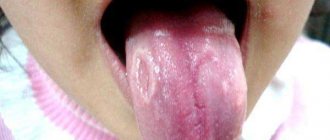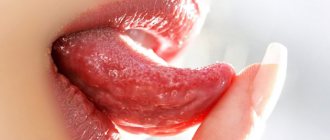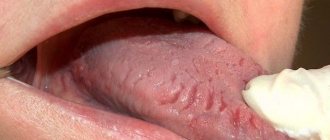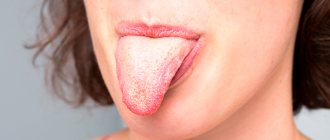Glossitis is an inflammatory process in the tongue. The disease itself has several varieties, and the success of its treatment largely depends on the correct diagnosis of the type of glossitis. Glossitis, like most diseases, is also divided into acute and chronic. The acute form of glossitis is characterized by inflammation of the tongue, changes in tissue structure, and color changes. Chronic glossitis has other symptoms, the main one of which is the presence of fungal round growths on the tongue (papillomas).
In dentistry, the following types of glossitis are distinguished:
- folded;
- desquamative;
- diamond-shaped median;
- hairy black;
- interstitial;
- Gunterovsky.
For the common man, the names are complicated, but we will try to talk in more detail about the causes, consequences and treatment of each type of glossitis.
At the Dentistry clinic on Shchelkovskaya "Diamed" we see experienced dentists-therapists who can accurately determine the form of the disease and prescribe an effective diagnosis. Our clinic is located in the same building as the multidisciplinary clinic “Diamed”, where you can receive professional medical care. Make an appointment with a dentist by calling 8 (495) 033-00-63 or using the online appointment form.
Symptoms of glossitis
With the development of glossitis, pain is often observed when eating, performing oral hygiene, talking and even touching. There is a change in color, swelling, and dryness of the tongue. Over time, ulcers and erosions appear on the tongue surface.
With superficial glossitis (that is, in its initial stage), inflammation of the mucous membrane of the tongue is observed, and the color of the tongue changes to bright red. The structure of the tongue becomes swollen, dense, and inactive. The tongue may also become coated and salivation increases. The patient feels a burning sensation and loses his sense of taste. Such symptoms also indicate that stomatitis has developed in the oral cavity.
If treatment for glossitis is not started at this stage, then the development of deep glossitis begins - inflammation penetrates into the deep layers of the tongue, phlegmon (purulent formation) is formed. Over time, the floor of the mouth may become affected, as well as inflammation of the neck or chin. Breathing may be significantly difficult, and a swelling of the tongue may form.
Desquamative glossitis
Desquamative glossitis is expressed in local destruction of the tissues of the tongue (most often on the lateral surfaces and back of the tongue). Destruction is accompanied by redness surrounded by a halo. With desquamative glossitis, regenerative processes are active; the epithelium can recover on its own. The duration and course of healing depends on the degree of redness and destruction of the epithelium. But after one lesion has healed, a similar one may immediately appear in another part of the tongue. That is why this type of glossitis is also called geographic. With the development of desquamative glossitis, the patient also feels pain and burning.
Folded glossitis
With folded glossitis, longitudinal or transverse folds appear on the linguistic surface. They have different lengths and widths. The most noticeable fold usually runs from the tip of the tongue to the root.
Diamond-shaped glossitis
When a patient develops diamond-shaped median glossitis, a thickening of the epithelium is observed, while a red-bluish inflammation of a diamond-shaped (less often oval) shape appears on the back third of the lingual surface in the middle.
Rhomboid median glossitis is a chronic disease, so inflammation can disappear and reappear. With this type of glossitis, the surface of the tongue becomes as if varnished. Over time, various rashes appear in the form of warts or papillomas.
Hairy black glossitis
Hairy black glossitis is accompanied by the growth of filiform papillae, which over time become increasingly denser and become hair-like. Most often they are black, sometimes they can be lighter, for example, yellow. The hairs can thicken to a height of one centimeter. Hairy black glossitis is also accompanied by uncomfortable sensations in the throat and sticking of the tongue to the roof of the mouth. Localization of glossitis in the back of the tongue (on the back) can also cause gagging.
Folded tongue
This is a congenital anomaly in which the tongue is excised by longitudinal and transverse folds, wavy, uneven at the edges. As a rule, the disease is accompanied by an increase in the size of the organ and its thickening; teeth marks can be seen on the sides. Usually the pathology is asymptomatic and does not cause discomfort; pain and inflammation can appear after infectious diseases, with the development of stomatitis or glossitis.
The folded tongue requires good hygienic care, since bacterial plaque easily accumulates in the cracks and creates a convenient environment for the proliferation of pathogenic bacteria. Such a disease is incurable; therapeutic procedures are necessary only when stomatitis and glossalgia develop.
Causes of glossitis
All forms of glossitis have common properties. Any glossitis can occur due to a viral or bacterial infection. Glossitis often occurs due to mechanical trauma to the tongue, chemical and thermal damage. Glossitis may also indicate the presence of a concomitant disease or allergy in the patient’s body. Glossitis can also develop against the background of another oral disease.
Let's highlight the most common causes of glossitis:
- tongue injury from sharp pieces of food or dentures;
- exposure to hot water and food, burns;
- improper and inconsistent oral hygiene;
- smoking, addiction to alcohol, poisoning with heavy metal salts;
- allergies to toothpaste, mouthwash components, orthopedic materials;
- the presence of herpes viruses, staphylococci, and yeast-like fungi in the body.
Glossitis can be a symptom of a general disease in the body. The most common cases of glossitis as a symptom of a concomitant disease are observed in the following diseases:
- infectious diseases (scarlet fever, measles and others);
- diseases of the gastrointestinal tract;
- blood diseases;
- hypervitaminosis;
- diseases of the oral cavity (especially stomatitis).
Also, different forms of glossitis can manifest themselves differently in different conditions of the body.
Thus, rhomboid median glossitis often accompanies chronic diseases of the gastrointestinal tract, especially low acidity of gastric juice. Also, rhomboid median glossitis often develops with disturbances in the development of the fetus during pregnancy and, thus, is a congenital anomaly of the tongue.
Desquamative glossitis can occur in women during pregnancy, as well as in diseases of the circulatory system, digestive disorders, metabolic disorders, and rheumatism. Desquamative glossitis is also common in lupus erythematosus. Very often, the desquamative form develops from folded glossitis.
The most mysterious type of glossitis for researchers is hairy black, or villous. Until now, scientists cannot name the exact reasons for its occurrence. The generally accepted version is the occurrence of hairy black glossitis under the influence of local irritating environmental factors. Scientists also tend to believe that villous glossitis develops under the influence of candidiasis (a disease caused by fungi) that develops after taking antibiotics. In cases where it is difficult to diagnose the main cause of glossitis, the presence of the disease may also lie in a hereditary predisposition.
Causes of gray plaque on the tongue
The reasons for the appearance of a grayish layer on an organ can be varied.
Among them are the following:
- Diseases of the digestive system: stomach ulcers, bile duct obstruction, gastritis, enterocolitis, etc.
- Infectious diseases: sore throat, pneumonia, measles, scarlet fever.
- Inflammation of the oropharynx, for example, tonsillitis and pharyngitis, both acute and chronic.
- HIV infection.
- Dehydration of the body, in which additional symptoms include dry mucous membranes and skin, a tendency to constipation, and fatigue.
- Taking courses of antibacterial therapy and the development of dysbacteriosis against this background. Hormonal medications can also cause this condition.
- Dietary disorders, in particular, consumption of excessively salty, spicy or fried foods.
- Liver diseases.
- Respiratory diseases. In particular, such pathologies include bronchitis, tracheitis, and pneumonia. After the human body copes with the infection, the tongue returns to its original pink color.
- Lack of basic hygienic skills for oral care. Not only regular brushing of your teeth, but also proper care of your tongue and gums will help you cope with this problem.
- An increase in body temperature can cause a gray film to form on the tongue.
Treatment of glossitis
After diagnosing glossitis based on the general clinical picture and data from the patient’s blood test, the doctor prescribes a treatment procedure. Treatment is primarily aimed at the main cause of the disease, and if it lies in the general condition of the body, then also at its improvement. Firstly, during treatment, too hot, sour and sweet foods are excluded from the diet. Secondly, to strengthen the immune system, it is prescribed to use a complex of vitamins (vitamin B, vitamin E).
Oral rinses and baths are very effective in treating glossitis. Solutions of furatsilin, chlorhexidine, and anesthetic solutions are used.
If ulcers are present, the tongue is treated daily. For treatment, a cotton swab is used, after which rinsing with antiseptic agents is carried out.
The doctor may also prescribe applications using a special gel rich in vitamins, carotoline, and rosehip oil, which has a healing effect.
It is very important during treatment and during prevention to monitor the general state of health and prevent the occurrence of diseases that contribute to the appearance of glossitis of the tongue.
Malocclusion
Incorrect bite formation leads to permanent injury to the mucous membranes of the mouth and tongue. As a result, the muscle organ swells and increases in size. Due to constant biting, teeth marks are left on the sides of the tongue.
The disease can be cured only after correcting the malocclusion. To do this, the doctor selects a design to straighten the dentition. For minor violations, patients are prescribed to wear orthodontic plates, trainers, and silicone trays. In case of more serious pathology, the defect is corrected using braces. The course of treatment can take from 3 months to 2 years.
Gastrointestinal diseases
The oral cavity and digestive organs are in direct communication. Diseases of the stomach and intestines cause acidity in the mouth, creating a convenient environment for the proliferation of bacteria. A persistent white or yellow bacterial coating appears on the surface of the tongue and mucous membranes, spots or erosions may form, the organ becomes inflamed and increases in size.
A symptom of the development of gastrointestinal diseases is the root of the tongue coated with plaque.
Peptic ulcers of the stomach, duodenum, duodenitis, dysbacteriosis, gastritis with high acidity, and colitis can cause such symptoms. Additionally, patients are bothered by abdominal pain, nausea, vomiting, heartburn, stool disorders, and flatulence.
To treat the pathology and eliminate plaque on the root of the tongue, you need to consult a gastroenterologist. During therapy, plaque and swelling disappear. If erosions have formed on the mucous membranes, it is necessary to do regular antiseptic mouth rinses with Chlorhexidine, Miramistin or Chlorophyllipt.
What to do if plaque appears?
If a pregnant woman detects a change in the color of her tongue, she does not need to panic, but should brush her teeth and tongue; some brushes have special surfaces for this purpose. If after this procedure it was possible to partially get rid of the plaque, but after a while the shade returned, then you need to consult a doctor without waiting for a scheduled appointment with a gynecologist.
If the development of pathology is suspected, the woman will be referred for general urine and blood tests, and hardware tests will be carried out. The main thing is not to delay diagnosis, not to self-medicate, but to immediately make an appointment with a doctor.
Diagnostics
To establish the cause of the formation of a gray coating on the tongue, it is necessary to carry out a wide range of diagnostic measures.
The first stage of diagnosis is:
- conducting a detailed survey;
- familiarizing the doctor with the patient’s medical history and life history;
- performing a physical examination, which must include palpation of the abdomen, as well as measurement of blood pressure, pulse and temperature.
This will enable the doctor not only to learn more about the causes of the main symptom, but also to obtain information regarding the complete clinical picture.
The next diagnostic step is laboratory examination, namely:
- clinical and biochemical blood test;
- microscopic examination of feces;
- special tests to identify pathological microorganisms;
- general urine analysis.
The last stage of diagnosis is an instrumental examination of the patient, which includes:
- radiography with or without contrast;
- biopsy - if necessary;
- CT and MRI;
- Ultrasound and FEGDS;
- other procedures prescribed on an individual basis.
In some cases, additional consultation with specialists may be required.
Carrying out FEGDS
Vitamin deficiency
If there is a lack of vitamins B and D in the human body, the surface of the tongue dries out, cracks, becomes inflamed, becomes coated, and bad breath appears.
When an allergic reaction to vitamins occurs, the muscular organ swells, and dents from the teeth are clearly visible on its lateral surfaces. With a lack of vitamin B₃, the organ cracks, painful sensations appear, and a burning sensation occurs while eating. If an infection occurs, an acute inflammatory process develops, purulent ulcers form, and the person’s well-being worsens. To treat the disease, it is necessary to compensate for the lack of vitamins in the body.
Liver diseases
In people suffering from serious liver diseases (viral hepatitis, cirrhosis of the liver), the tongue has a characteristic appearance - the mucous membranes are red, hyperemic, the surface is smooth, glossy, the papillae are smoothed. Often such symptoms are accompanied by swelling of the organ and an increase in its size, as a result of which the edges are constantly bitten by the teeth, forming wavy sides.
Among the additional external symptoms, patients note the appearance of spider veins, xanthomatous plaques, and erythema (redness) of the palms on the surface of the skin. Patients complain of pain in the right hypochondrium, nausea, vomiting, indigestion and stool disorders.
The disease must be treated by a general practitioner, infectious disease specialist, surgeon or oncologist.











